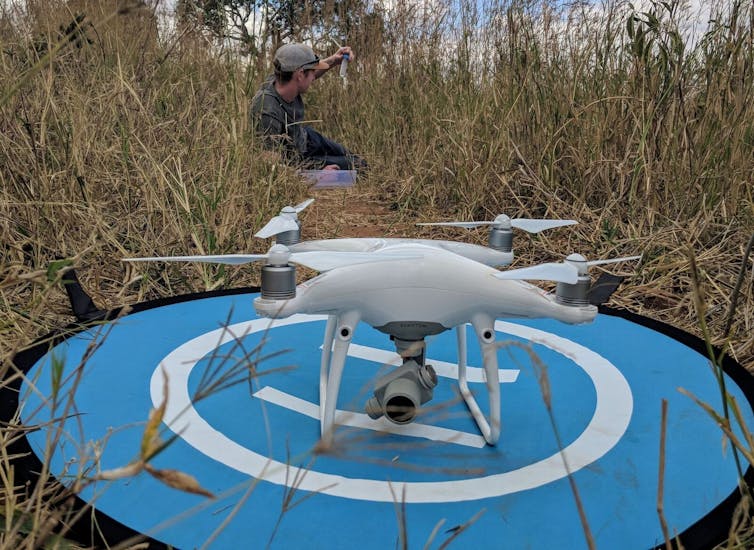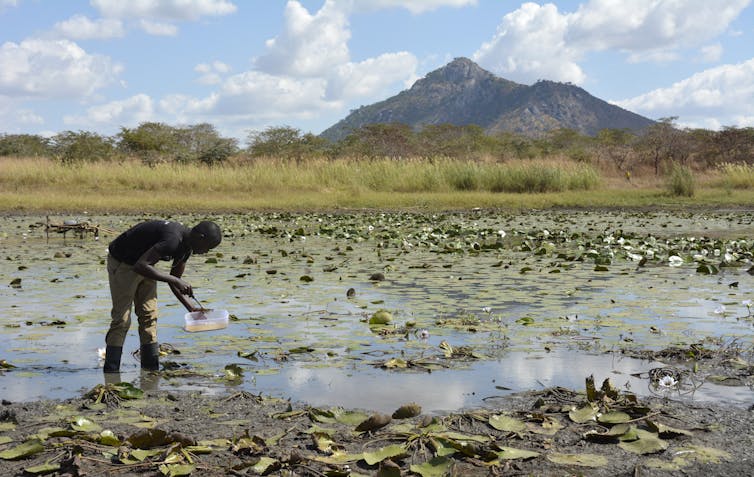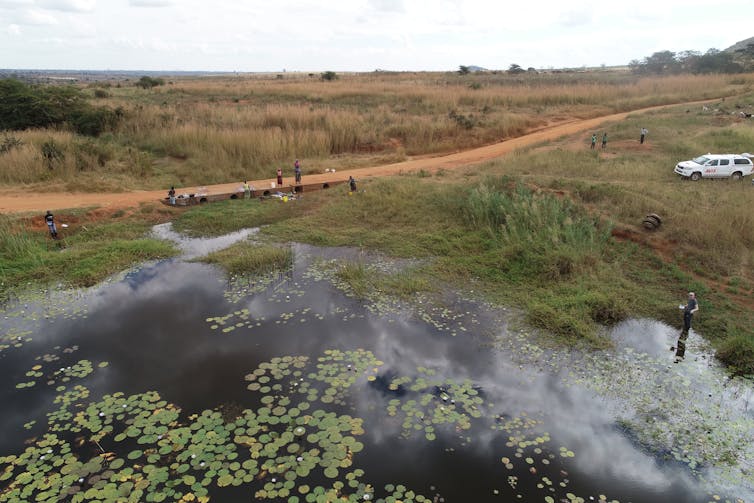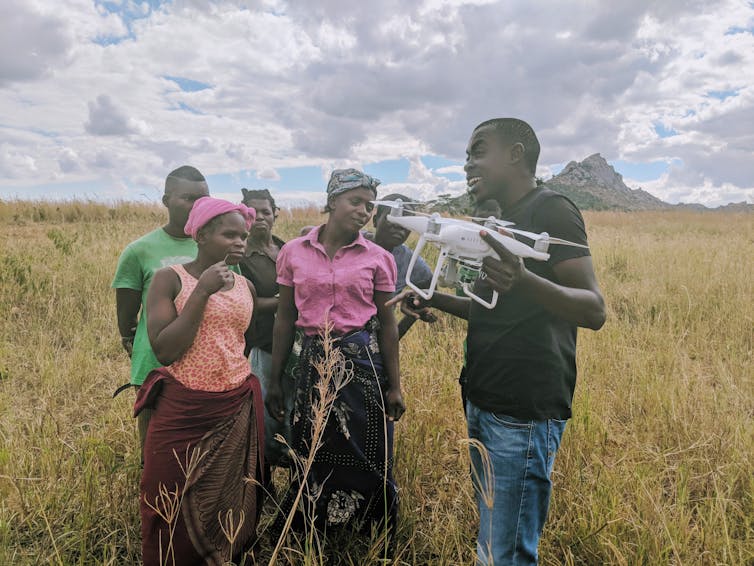
The drone makes a conspicuous racket as it lifts off on a mission to capture images of the reservoir below. The sight and sound of this strange device stirs interest among locals as they make their way to and from the town of Kasungu in central Malawi. It takes a matter of minutes for a small crowd to form.
A few yards away, Patrick Kalonde is wading through grass and mud. Patrick, an intern at UNICEF working on humanitarian uses of drones, is carrying a plastic container and a ladle and is looking for mosquito larvae. The contrast between high-tech drones and low-tech “bucket-and-spade” science, metres apart, could not be starker – yet both are equally important to the success of our new project to map where mosquitoes breed.

Kasungu, a small town at the base of the picturesque Kasungu Mountain, is the centre of Africa’s first humanitarian drone testing corridor. Set up by UNICEF in 2017 with support from the Malawi government, the corridor is an 80km-wide area for flying and testing drones to help the local people.
Keen to dispel the reputation that drones are only useful for destruction, the UNICEF corridor promotes “drones for good”. Without this programme, getting our project up and running would have been a much more arduous task. You can’t send a drone into the sky wherever you like, so we were delighted when they accepted our request to use the corridor.
So far, projects have been launched in the corridor to deliver emergency supplies to inaccessible rural areas, to map cholera outbreaks, and to train the next generation of Malawians to build and pilot drones. We’re in Kasungu to add the fight against malaria to the list.
The number of deaths attributed to malaria has declined considerably since the turn of the century, yet the disease continues to wreak havoc across Africa. In Malawi, nearly a quarter of children under five years old test positive for the disease. Gains are being made through measures such as providing free mosquito nets, but there is still a long way to go before the goal of eliminating malaria is achieved.
You may wonder what this has to do with reservoirs and drones. Malaria and water are inextricably linked. A few days after taking a blood meal from an unsuspecting human or animal host, the malaria-carrying female Anopheles mosquito searches for water in which to lay her eggs. During the rainy season – between November and April – it is not too difficult for her to come across a small puddle or pool. Mosquitoes flourish during this period – and malaria peaks soon after.

When the rains subside, breeding sites become much more sparse, leading to the often asked question: “Where do mosquitoes go in the dry season?”
Not only could mapping mosquito breeding sites determine which areas are prone to malaria transmission, they could provide the information to reduce mosquito numbers in water bodies through environmental management. Prevent mosquitoes from breeding – especially in those sparsely available sites in the dry season – and we could make a significant impact on local malaria cases.
Mapping the breeding sites
Kasungu district is dotted with reservoirs that supply water to the local farms. When we arrived in June the waters had receded, leaving a shallow and muddy shoreline with plenty of vegetation. The ideal breeding ground for Anopheles mosquitoes, and an excellent area in which to focus our efforts, particularly as other researchers have found a link between reservoirs and increased malaria transmission.
Dipping a ladle into the muddy water’s edge, it doesn’t take Patrick long to find a few Anopheles larvae. We’re in the right place. By 11am, even in the mid-winter of Malawi, it is hot. Sampling for mosquitoes is tough work – a task routinely performed by national programmes to support malaria control. We want to find out if imagery captured by drones can make this process cheaper and more efficient.
When the sun sets and the temperature drops, our attention switches to processing all the drone data to see if we can use it to identify potential breeding sites. While this part of the process has the potential to become very complex and expensive depending on the software used, we are mindful that we won’t be undertaking this analysis in the future. It will be a task that local malaria control officers will perform, so user-friendliness is as important as accuracy.

We’re one week into our initial study, and we have captured some spectacular images of Kasungu reservoirs and waded in muddy shorelines, finding plenty of mosquito larvae along the way. Putting together evidence from on-the-ground insect surveys and drone imagery is the next task, but our early experience makes us confident of pinpointing areas where mosquitoes are hiding out.
As we reach the end of another beautiful but exhausting day, the drone begins its final descent and Patrick heads back to the car with his small tub of reservoir water. The small crowd gathered at the roadside comes in to take a closer look, and Patrick begins his now well-rehearsed explanation of how we’re flying the drone to try to find “udzuzu” (mosquito in the local Chichewa dialect).
![]() As the conversation develops, several of the crowd tell us of their own experiences of malaria, and of their hope that there’s something that can be done to put a stop to this disease that has an impact on so many people. We hope that this project will be able to make a difference.
As the conversation develops, several of the crowd tell us of their own experiences of malaria, and of their hope that there’s something that can be done to put a stop to this disease that has an impact on so many people. We hope that this project will be able to make a difference.
Michelle Stanton, Medical Research Council Fellow, CHICAS, Lancaster Medical School, Lancaster University and Christopher Jones, Senior Lecturer in Vector Biology at the Liverpool School of Tropical Medicine and Malawi-Liverpool-Wellcome Trust Clinical Research Programme
This article was originally published on The Conversation. Read the original article.

